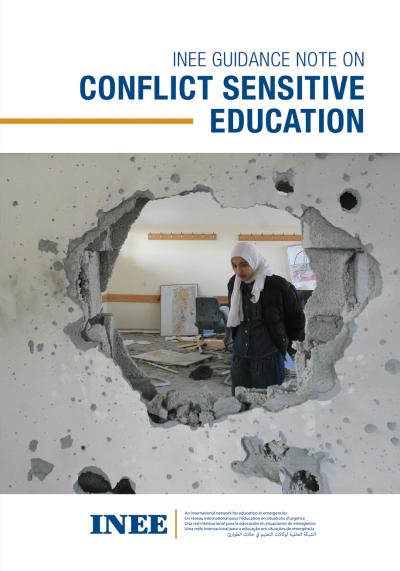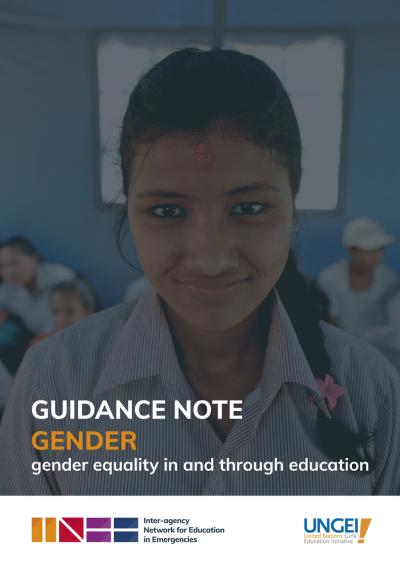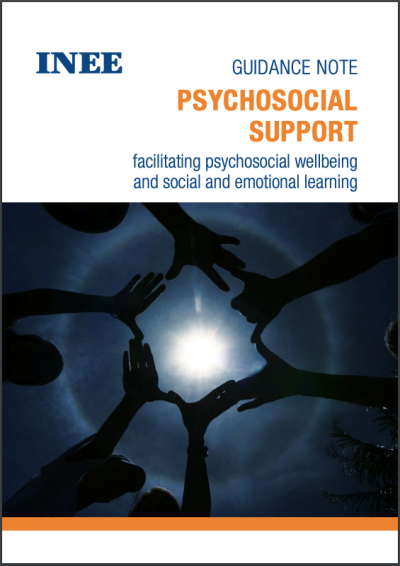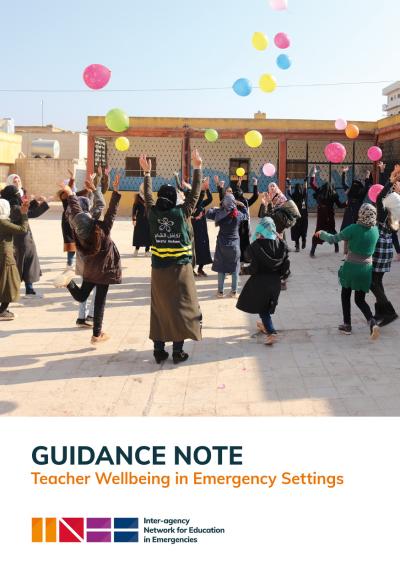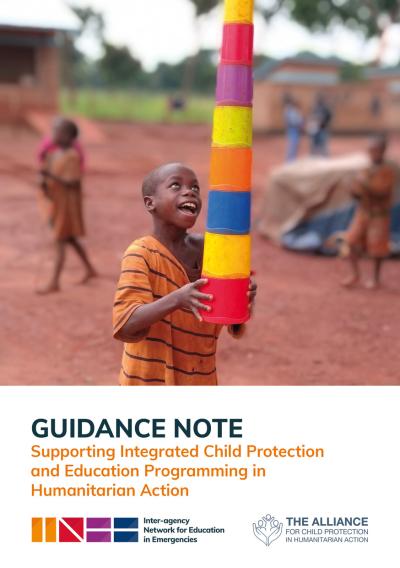Standard 12: Teaching and Learning Processes
Teaching and learning processes are learner centered, participatory, and inclusive.
في هذة الصفحة
1. Appropriate teaching approaches: Promote teaching approaches that are appropriate to the age, developmental level, language, culture, capacities, and needs of learners.
أنظر للملاحظات الارشادية:
2. Lesson content and teaching skills: Confirm that teachers are able to understand the lesson content and have strong teaching skills when they interact with learners.
أنظر للملاحظات الارشادية:
3. Barriers to learning: Promote inclusive teaching and learning and reduce learning barriers in order to fulfill the needs of all learners.
أنظر للملاحظات الارشادية:
4. Community endorsement: Engage with parents and community leaders so they will be able to understand and support the learning content and teaching methods used.
أنظر للملاحظات الارشادية:
Teaching approaches should encourage all learners to be active and to feel safe and confident enough to participate fully. Teaching methods should emphasize inclusivity and work to identify and address any potential bias and prejudice in the learning environment. If teachers are expected to develop or select teaching materials, they should be trained to recognize bias and to ensure that the materials they choose are inclusive and age appropriate. Teachers can create opportunities for learners to work in different ways, both independently and collaboratively in groups of different sizes. Using varied approaches can help support learners’ academically and will promote their development of social and emotional skills, such as communication, collaboration, self-awareness, and empathy. Teachers can explore play-based learning, as young children can benefit from hands-on learning experiences (see the EiE Glossary for a definition of play). If distance education is used, teachers will need training in how to support remote learners.
Teachers may find new methods difficult to implement, especially during an emergency. They will need ongoing support from their peers, mentors, and teacher trainers. Teaching methods used for higher education or TVET will also need to be adapted to the crisis context. Peer support groups, self-study, or distance education approaches may be helpful adaptations to support these learners. TVET learners will still need hands-on experience with practical tasks, so their teachers may need to use videos to demonstrate these skills. Higher education learners may be better able to adapt to distance education than those who are younger, but they may face other challenges, such as access to technology, internet, and electricity. They will need support from their peers, teachers and other education personnel, and tutors.
Local education authorities should approve, organize, and support changes in teaching methods in formal and non-formal education. It is also important that the community, parents and caregivers, and learners understand and support the changes.
Emergencies may result in the loss of essential teaching and learning resources that teachers rely on in their classes. When textbooks have been damaged or destroyed, were lacking prior to the emergency, or are no longer relevant, the national education authorities may need to find replacements or develop new materials that include new content or revisions of problematic content. This often takes time and funding, so a short-term response that is locally produced or co-created with teachers may be needed. Teachers may also rely on their memory and knowledge of content and pedagogy. Education authorities should take the lead in the development and dissemination of teaching and learning resources. They may coordinate efforts with the inter-agency coordination mechanism, where it is present. Training and professional development should be guided by the resources available. Where resources are limited, education stakeholders can help teachers draw from other forms of knowledge and co-create content with their peers. It is important for teachers who have no previous experience to have strong role models or mentors, and adequate guidance to ensure that the foundations of teaching are applied in their classrooms.
Teachers may need to rely on what teaching and learning materials are available, including textbooks. Textbooks often include teacher notes and guidance on teaching specific content, which suggest teaching approaches and can help teachers understand the content. The guidance may encourage teachers to have learners engage in group work, to ask learners open questions, and to provide space and opportunity for learners to ask their own questions.
Teachers and other education personnel should structure lessons so that the learning objectives are stated clearly at the beginning of the lesson, repeated throughout, and summarized at the end. Learners can contribute to this process with help from their teacher, who can help them structure and scaffold their thinking, give constructive feedback, and encourage other learners to ask and respond to questions.
The content of non-formal education depends on who the learners are, their stage of development, the program objectives, the nature of the crisis, and the social, political, and economic environment. The knowledge and skills non-formal education teachers need will depend on what knowledge, skills, and attitudes their learners will need when they later transition to formal educational institutions, seek employment, and participate in the community. This might include literacy and numeracy, social and emotional skills, livelihood training, or knowledge of safety and security measures. As in formal education, the training and support of non-formal education teachers, volunteers, facilitators, and caregivers should model varied approaches that are inclusive and confidence building.
Teacher training and professional development should establish benchmarks for understanding and applying knowledge and teaching content. Additional systems should be in place to continually monitor teachers to ensure that they have the skills and knowledge to teach the content effectively. Support can be provided as needed.
Taking an inclusive approach is key to reducing barriers to learning. This means that teachers should embrace diversity, create a sense of belonging, and meet the needs of all learners.
Learners with disabilities, both hidden and visible, should have ongoing access to education during an emergency. These learners must not be excluded because of perceived challenges in providing access, or because education authorities, teachers and other education personnel, or even family members or caregivers do not prioritize their needs. Education officials, community leaders, and other stakeholders can advocate and communicate with parents and caregivers, and the wider community, about the importance of inclusion for learners with disabilities. When needed, specialized organizations and associations, such as OPDs can provide additional support for these children and young people. It is important to ensure that learners with disabilities, which may include sensory, physical, mental, cognitive, and developmental disability, have access to assistive devices and technologies. This can include low-tech or no-tech options, like communication boards, which may have been lost during an emergency.
Young women and girls face compounding barriers to learning, such as SRGBV, increased risk of early marriage and early pregnancy, increased burden of unpaid care work and domestic labor, and in some contexts, cultural norms that may prioritize educating boys over girls. Many of these barriers are made worse by crises. Education authorities, community leaders, and other stakeholders should work with parents and caregivers, and the wider community, to raise awareness about the importance of education continuity for young women and girls and to ensure that they have enough time and resources to learn. When needed, women’s rights organizations and feminist and youth organizations can provide additional support.
Learning materials will address diversity and inclusion in various ways. Teachers and other education personnel should receive professional development, including training on disability-inclusive and gender-responsive pedagogy, to help them teach inclusively and to manage any discrimination or bias that emerges in the learning environment (for more guidance, see INEE Guidance Note on Gender; INEE Pocket Guide to Supporting Learners with Disabilities).
Emergencies may create opportunities to introduce teaching content that responds to the impact of the crisis or seeks to address its underlying causes. Examples include teaching environmental stewardship in response to climate-related crises, and conflict resolution and peacebuilding skills during a conflict. Teachers may acquire and apply new skills and knowledge in their teaching, such as learner-centered approaches to supporting learners’ overall wellbeing, and their academic and social and emotional development.
These new approaches may be unfamiliar to parents and caregivers and the community. Therefore, education actors should find opportunities to inform caregivers and communities of new content and methodologies, and work with them to identify additional gaps in the content or other methodologies that draw from local and indigenous methods. They also should raise awareness of the intended impact of new content and methodologies and strengthen their relevance by creating connections between learning in class and learning at home. Efforts to raise awareness may also encourage the community to increase support for and become more engaged in education.
المؤشرات
| INEE Domain | INEE Standard | Indicator/Program Requirements | Clarification | Numerator | Denominator | Target | Disaggregation | Source of Indicator | Source of Data | Available Tool | Crisis Phase | |
| Teaching and Learning | Curricula (T&L Std 1) Culturally, socially and linguistically relevant curricula are used to provide formal and non-formal education, appropriate to the particular context and needs of learners. |
3.1 Pupil-textbook ratio | Number of students | Number of textbooks | 1:1 | Level of education Gender Ethnicity Mother tongue Wealth quintile Disability Displacement status As relevant |
New | School administrative data | Right to Education Monitoring Guide | All stages | ||
| 3.2 Percentage of targeted learning spaces whose learning materials meet minimum quality standards | Curricula, textbooks, and other learning materials should be inclusive, conflict-sensitive, gender-transformative, promote SEL and PSS, etc. | Number of targeted learning spaces where learning materials meet minimum standards of quality | Number of targeted learning spaces | 100% | Formal vs non-formal | New | Learning material analysis | Tool required | All stages | |||
| 3.3 Percentage of students in the right grade for their age | Number of students at a grade level appropriate to within one year of their age | Number students | 100% | Level of education Gender Ethnicity Mother tongue Wealth quintile Disability Displacement status As relevant |
New | School administrative data | No tool required; INEE MS and indicator definitions sufficient | All stages | ||||
| 3.4 Percentage of targeted crisis-affected children and youth benefiting from relevant skills development (SEL / PSS / risk awareness / environmental education / conflict prevention) | Number of targeted crisis-affected children and youth benefiting from relevant skills development (SEL/PSS/risk awareness/ environmental education/conflict prevention) | Number of identified crisis-affected children and youth needing relevant skills development (SEL/PSS/risk awareness/ environmental education/conflict prevention) | 100% | Level of education Gender Ethnicity Mother tongue Wealth quintile Disability Displacement status As relevant |
New | Learning outcome measures | Tool required | All stages | ||||
| 3.5 Percentage of targeted learning spaces utilizing curriculum aligned to national standards | In formal settings, the national curriculum should be used. In non-formal settings, the curriculum should be appropriate and compatible with the national curriculum. | Number of targeted learning spaces utilizing curriculum aligned to national standards |
Number of targeted learning spaces |
100% | Formal vs non-formal | New | Program documentation | Tool required | All stages | |||
| Training, Professional Development and Support (T&L Std 2) Teachers and other education personnel receive periodic, relevant and structured training according to needs and circumstances. |
3.6 Percentage of teachers who show increased understanding of and practice Teacher’s Role & Well-being; Child Protection, Well-being; Inclusion; Pedagogy; Curriculum & Planning; and Subject Knowledge | Number of teachers who show increased understanding of and practice Teacher’s Role & Well-being; Child Protection, Well-being; Inclusion; Pedagogy; Curriculum & Planning; and Subject Knowledge | Number of teachers | 100% | Gender | TiCC | Classroom observation, teacher survey | World Bank's open-source classroom observation tool Teach | All stages | |||
| 3.7 Teacher satisfaction level with TPD activity/activities they have participated in | Number of teachers satisfied with TPD activities they have participated in | Number of teachers | 100% | Gender | TiCC | Teacher survey | Tool required | All stages | ||||
| 3.8 Percentage of teachers who report feeling confident in their ability to teach effectively | Number of teachers who report feeling confident in their ability to teach effectively | Number of teachers | 100% | Gender | TiCC | Teacher survey | Tool required | All stages | ||||
| 3.9 Percentage of teachers and other education personnel benefiting from professional development according to assessed needs | Number of teachers and other education personnel benefiting from professional development according to assessed needs | Number of teachers | 100% | Gender | New | Program administrative data | Tool required | All stages | ||||
| 3.10 Degree of teacher professional development recognition and/or certification | Number of teachers whose TPD is recognized or certified | Number of teachers | 100% | Gender | New | Program documentation | Tool required | All stages | ||||
| Instruction & Learning Processes (T&L Std 3) Instruction and learning processes are learner-centred, participatory and inclusive. |
3.11 Percentage of teachers whose training included methods for how to engage all students equally and in a participatory way | Number of teachers whose training included methods in how to engage all students equally and in participatory way | Number of teachers | 100% | Gender | New | Teacher survey | Tool required | All stages | |||
| 3.12 Appropriateness of teaching methods to the age, developmental level, language, culture, capacities, and needs of learners | Scale 1-5 (1 = low, 5 = high) | 5 | NA | New | Classroom observation | World Bank's open-source classroom observation tool Teach | All stages | |||||
| 3.13 Percentage of teachers who use structures or routines to manage classroom interactions more effectively | Number of teachers who demonsrate effective use of structures or routines for managing classroom interactions | Number of teachers | 100% | Gender | New | Classroom observation | World Bank's open-source classroom observation tool Teach | All stages | ||||
| 3.14 Frequency of parental engagement in communications that inform them of learning content and teaching methods | Number of parent-teacher engagement sessions | Per year | To be defined by program | NA | New | program documentation | No tool required; INEE MS and indicator definitions sufficient | All stages | ||||
| Assessment of Learning Outcomes (T&L Std 4) Appropriate methods are used to evaluate and validate learning outcomes. |
3.15 Percentage of teachers capable of assessing learning progress | Number of teachers who are trained in and use continuous student formative learning assessments | Number of teachers | 100% | Gender | New | Classroom observation | World Bank's open-source classroom observation tool Teach | All stages | |||
| 3.16 Degree of use of accreditation, certification, and recognition | Measures whether students' learning achievements are formally recognized through accreditation, certification, or some other form of recognition. This is particularly relevant when completing levels, such as primary or secondary | Scale 1-5 (1 = low, 5 = high) | 5 | NA | New | Program documentation | No tool required; INEE MS and indicator definitions sufficient | All stages | ||||
| 3.17 Learning assessments are available in first languages | Number of languages available for assessments | Number of first languages | 100% | NA | New | program documentation | No tool required; INEE MS and indicator definitions sufficient | All stages | ||||




